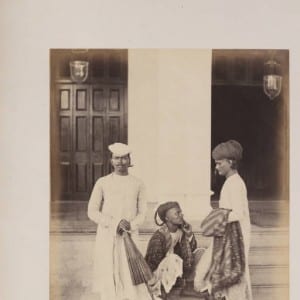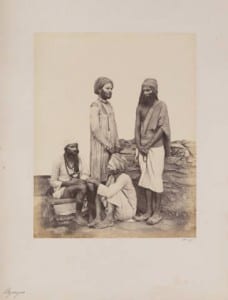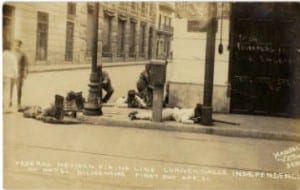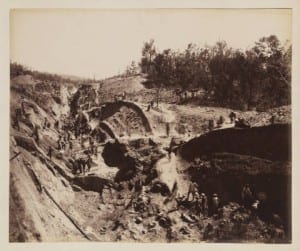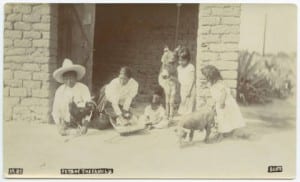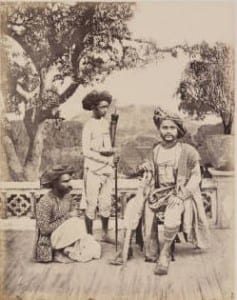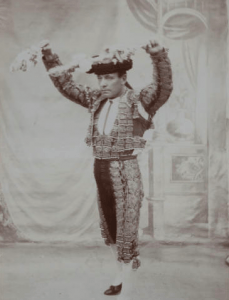Three men stand looking powerful and pensive in this image. The photo is entitled the Marwarree Brokers, which suggests they are involved in business and are probably apart of the Kshatriyas caste and are relatively wealthy and respected. The existence of brokers suggests that the economy in India during this time was pretty sophisticated. The men are from the Marwar region in India, which is located in the northwestern part of the country. These men give a glimpse of what a successful businessman might look like in India in the 1850s or 1860s. They are closer to the top of the caste system and are successful in an economically oppressive colonial system because of being brokers which is more esteemed employment that an average merchant. Marwarree Brokers shows some Indians who had comfortable lives during the colonial period with fine clothing and an affluent place in society.
Glimpse of Mexican railway

- Primer puente a la Barranca infiernillo
This photograph was taken by Abel Briquet. In this photograph, a completed railroad is present. This railroad appears to be coming out of a tunnel along a hilly region. One can see a clear section of the railroad, which serves as a bridge along a hilly region. This image was taken in Veracruz-Llave, Mexico. From the environment of the image, we can deduce that this railroad could be along a canyon or a mountain of some kind. The title of the photo reaffirms this deduction. Primer Puente a la Barranca infiernillo is translated to first bridge to “Little Hell” Canyon. From the title, we can also deduce that the railroad in the photo is the first section of a long railroad along the canyon. It can also be deduced that Mexican workers clearly made this railroad. How was this railroad made in such a dangerous location? How safe can this railroad itself be? Where does this railroad lead to and what is its purpose?
http://digitalcollections.smu.edu/cdm/singleitem/collection/mex/id/1709/rec/18
Guanajuato Market

This image is a snapshot of a typical moment occurring in a market in the streets of the Mexican city, Guanajuato. Children and women are seen managing the stalls while others browse through various hand made items that are displayed under tents along the sides of the buildings. The street is narrow because of the vendors’ stalls and it appears as though the tents line the street over hills and around bends and curves for quite a while. Having this image provides a lot of insight as to what trading and how the economy operated during this time. The picture was taken in the late 1800s, and the main mode of commerce at the time was in plazas and marketplaces much like this scene. Many of the goods were handmade by artisans who specialized in their craft and there were produce and other food products for sale as well. The way the Mexicans conducted business suggests that much of their business was locally centered and revolved around the nearest town where rural people could converge upon to trade their goods.
Civilized Discussion
Byragees is an interesting photo that shows four men discussing something in a pensive manner within some type of structure. The four men are dressed very similarly, all wearing loose cloth and wearing turbans as headwear. A fairly simple photo, besides clothing and the structure that they are in, there are no objects with the men. One can deduce that these men follow strict societal or religious guidelines, based on their facial hair and the way they all dressed. Additionally, they appear to be in a deserted area, as there are no buildings, people, or things evident in the background of the picture. Lastly, the men appear to be in a peaceful discussion, avoiding tension or conflict in their conversation. One question that arises it: what is the structure that they are standing on and sitting in? Also, out of curiosity, I wonder what they are discussing?
Federal Mexican Firing Line During Revolution
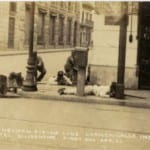
This photo, entitled Federal Mexican Firing Line Corner, depicts federal Mexican military units entrenched on a street corner in Veracruz, on the Gulf coast of the country. Immediately, the viewer is made aware of the armed conflict taking hold of the city, with modern (for the time) military equipment and rifles visible in the hands of the soldiers loyal to the Mexican army. During this time, there was a widespread, armed struggle between the Mexican government and revolutionaries that did not end until 1920. Though the soldiers appear to be in the midst of conflict, the presence of both the two standing figures, presumably officers, as well as the photographer, indicate that it was not as violent a situation as initially shown. Another aspect that stands out is the clear affluence of the city of Veracruz during this tumultuous period. Well maintained metal letterboxes, European-style building foundations, carved streetlights, and balconies combine to create a scene reminiscent of any Parisian street block during the same time period, if one discounts the armed soldiers in the foreground. This photograph helps capture the armed conflict in Mexico during this period, and how widespread the rebellion truly was, engulfing most of the major cities in the country. This photograph leads me to question the state of control the city of Veracruz was in when it was taken, and how accurate this photo is at depicting the readiness and organization of the Mexican army. In the photograph, the soldiers appear well-trained, by using cover, as well as being equipped with modern rifles, in addition to the presence of an officer speaking to an unidentified man. However, this, as indicated by the casualness of some of the figures in the picture, could not be accurately representing the scene captured by the photograph and thus potentially not accurately representing the state of the federal Mexican army at the time.
Glimpse of Indian Railway production
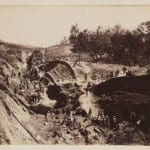
- [Bengal-Nagpur Railway Construction, Photograph No. 23]
This photograph was taken by Townshend. In this photograph, the land has been dug up. There is no vegetation or trees and only dirt and gravel among the digging site. However, there appears to be a lot of trees and vegetation on the land outside the digging site. There are also many Indian workers depicted in this image. From this image, we can deduce that the Indian workers are the ones who dug up this land and are laying the groundwork for a massive construction project, such as the construction of a railroad. It can also be deduced that an act of deforestation might have occurred in order to lay the path for the future railroad or construction project. This photo also suggests that a significant amount of Indian workers were needed for this construction, especially due to a lack of machinery present. How long would it take the Indian workers to complete a project as invasive as this one photographed with the lack of resources they had? What was the environmental impact of a construction operation like this?
http://digitalcollections.smu.edu/cdm/singleitem/collection/eaa/id/1483/rec/24
Daily Affairs
“Pets of the Family” is an interesting picture that appears to depict a young family conducting their daily activities with their pets, which are probably used to provide value to the family in their daily endeavors. . One may notice a chicken, a mule, and a pig that are lingering with the family and being supervised by various family members. Also, there is a gourd and a tub, which appear to be helping the mother wash items for the family. Lastly, there is a structure that is built on dirt that could either be a utility shack or a home for the family. The father, daughter, and son are all watching over the family’s animals, which seem to be fairly disciplined and do not need close supervision. The mother is working rigorously to wash items in a tub of water and also watching her husband conduct his activities. This picture allows one to deduce that in early Mexican societies, members of the family were expected to work and contribute to familial matters even at considerably young ages, as the young boy and girl are watching the family’s animals. By the family’s clothing and the structure that appears behind them, one can deduce that this family is middle/lower class and must work hard to make ends meet. Lastly, we may deduce that the animals are essential to the liveliness of the family and that they are very helpful in providing for the family. After analyzing the picture, I would like to know what exactly the animals are used for and how they provide value.
Analysis of a Mahratta Chief and his Attendants

This photograph, entitled Mahratta Chief and his Attendants, depicts an affluent Indian chief sitting with two servants waiting on him. The Chief is sitting, staring intently at the camera, whereas his two aides’ eyes are caste towards him. While the leader sits in an ornate, carved wooden chair the others must either stand or sit on the floor, another reminder of the power difference in the three characters. In the background, an intricate stone wall is seen, before dropping off to reveal a lake and various foliage. From this small window into their world, the viewer can already get the sense this was part of an ornate estate. Which, upon further research regarding the Maratha (another spelling of Mahratta) clans, would make sense as they have historically been one of the most powerful ruling classes in India, controlling much of the Indian subcontinent before Britain consolidated its rule, as well as commanding the largest bloc of Indian princely states under British Raj rule. The chief is pictured holding a sword in its scabbard, demonstrating the warrior history traditionally associated with the Maratha dynasty. Furthermore, the chief is dressed in ornate, princely clothing, including a fine-crafted, colored shawl, whereas his compatriot standing is dressed in plain, white cloth. One final thing of notice is the facial hair on both the older men, as the photograph is dated circa 1855-1862 – a period of time in Britain where facial hair became a wildly popular fashion style, in contrast to the clean shaven styles seen in the years beforehand. This could indicate that, although the chief belonged to a powerful, wealthy Indian clan, even he was susceptible to British cultural influence. This photograph leads me to question where, exactly, this was taken, primarily to learn the extent of British influence in the region during the photograph’s period. I also would question for what purpose was the photograph taken? Was it part of a documentation trip led by British colonialists, or was it at the request of the chief pictured?
Occupations in India and Mexico
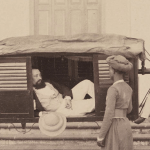
The photograph titled, Ghatee Hamalls, or Bearers, was taken around the 1850s or 1860s by William Johnson, and displays six men outside a building. In the center of the photograph, there is a man who appears to be lounging in a raised-up compartment. The fact that he is being carried insinuates that he is too important to have to walk anywhere by foot. He is dressed in all white, has a beard, and is the palest of the 6 men, which most likely means that he is British. The lounging man is seen talking to a darker man in darker clothes. It is hard to tell what class the darker-clothed man is from without further context, however, his put togetherness implies that he is of higher rank than the four men carrying the compartment, yet still answers to the man being carried. The last four men are wearing nothing but pieces of cloth, which suggests that they are of significantly lower class than the other two men. Given that Bearers is the title of the photograph, it is safe to assume that these four men are the bearers, or the male servants, of the wealthy British man that they are tending to. This photograph visually represents two, maybe even three, of the class levels that were prominent in 19th century India.
C.B. Waite photographed the ‘Corilo’ Banderillero in 1904 in Mexico. In English, “banderillero” means “bullfighter.” Pictured is a banderillero with his arms in the air, holding a banderilla, or small flag. Bullfighting, and other human vs. animal events are often linked to Rome and various Mediterranean countries. In Spain, bullfighting was used as entertainment for the king and his guests during times of celebration, and was later brought to Mexico by conquistadors. While it is a gruesome tradition, it has been linked to many religious festivals. The banderillero in the photograph is wearing elaborate, expensive looking clothing, which suggests that he is wealthy or that bullfighting is a respected sacred tradition. Because of the danger associated with bullfighting, it is possible that bullfighters earned a great deal of respect in society for their bravery.
The Four Female Salon
This is a photo taken by the photographer Winfield Scott who was known for a more upclose and personal way of taking photos without much thought of respecting the culture. The title of the photo is Three girls and a woman checking hair and was taken between 1895 to 1910 just before the beginning of World War I. The photograph it is a part of the Thomas Hudson Thatcher collection of Mexico and Texas photographs. There are three girls and a woman in this photo that all seem to be inspecting or taking care of the hair of the person in front of them. The way the women are placed order can also be seen in modern times of girls doing each other’s hair. It is not easy to tell if the females are uncomfortable or not with being photographed, but two of the girls are clearly interested and looking at the camera while the other two focus on what they are doing. They do not seem very wealthy by being in front of a door held together with sticks and on the dirt ground with very simple clothing. This photo clearly shows the close bond between the Mexican females and the children of a family with no sign of any men in the photo. The picture makes me wonder where this little home is or if there really is no man present in the lives of these females.
http://digitalcollections.smu.edu/cdm/singleitem/collection/mex/id/665/rec/3

